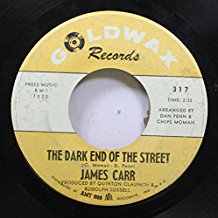"The Dark End of the Street" is a 1967 soul song, written by songwriters Dan Penn and Chips Moman and first recorded by James Carr. It became his trademark song, reaching number 10 on Billboard Magazine's R&B Chart, and crossing over to number 77 on the Billboard Hot 100.
| "The Dark End of the Street" | ||||
|---|---|---|---|---|
 | ||||
| Single by James Carr | ||||
| from the album You Got My Mind Messed Up[1] | ||||
| B-side | "Lovable Girl" | |||
| Released | 1967 | |||
| Genre | ||||
| Length | 2:20 | |||
| Label | Goldwax | |||
| Songwriter(s) | ||||
| Producer(s) |
| |||
| James Carr singles chronology | ||||
| ||||
History and original recording
editThe song was co-written by Penn, a professional songwriter and producer, and Moman, a former session guitarist at Gold Star Studio in Los Angeles and also the owner of American Sound Studio in Memphis, Tennessee. The song itself was ultimately recorded across town at Royal Studios, home of HI Records.
In the summer of 1966, while a DJ convention was being held in Memphis, Penn and Moman were cheating while playing cards with Florida DJ Don Schroeder,[4] and decided to write the song while on a break. Penn said of the song “We were always wanting to come up with the best cheatin’ song. Ever.”[5] The duo went to the hotel room of Quinton Claunch, another Muscle Shoals alumnus, and founder of Hi Records, to write. Claunch told them "Boys, you can use my room on one condition, which is that you give me that song for James Carr. They said I had a deal, and they kept their word.” The song, lyrics and all, was written in about 30 minutes.[6]
Chart performance
edit| Chart (1967) | Peak position |
|---|---|
| US Billboard Hot 100[7] | 77 |
| US Billboard Top Selling R&B Singles[8] | 10 |
Influences
editVan Morrison's song "Bright Side of the Road" includes the lyrics "From the dark end of the street, to the bright side of the road," which some people believe was influenced by Penn and Moman's song.[9]
Cover versions
editMany artists have recorded versions of the song, but none charted as highly as Carr's version.[10] In 1970, Aretha Franklin released a version on her album This Girl's in Love with You;[11] this interpretation was praised by musicologist Craig Werner as adding "something absolutely original", with Franklin implying a further final step in the song's story, a determination of the illicit couple to stand together.[12]
References
edit- ^ "www.allmusic.com". allmusic.com. Retrieved March 15, 2023.
- ^ Billboard Staff (October 19, 2023). "The 500 Best Pop Songs: Staff List". Billboard. Retrieved February 11, 2024.
...'60s soul classics like Aretha Franklin's "Do Right Woman, Do Right Man" and James Carr's "The Dark End of the Street
- ^ Stanley, Bob (13 September 2013). "Crying in the Streets: Deep Soul". Yeah Yeah Yeah: The Story of Modern Pop. Faber & Faber. p. 256. ISBN 978-0-571-28198-5.
- ^ Guralnick, Peter (2002).
- ^ Gordon, Robert (2001).
- ^ Hoskyns, Barney (1998).
- ^ Whitburn, Joel (2013). Joel Whitburn's Top Pop Singles, 14th Edition: 1955-2012. Record Research. p. 142.
- ^ Whitburn, Joel (2004). Top R&B/Hip-Hop Singles: 1942-2004. Record Research. p. 104.
- ^ Bailie, Stuart (July 6, 2008). "Playlist". Bbc.co.uk. Retrieved July 29, 2008.
- ^ Andrews, Kehinde; Dunbar, Erica Armstrong (2023). Black America: Historic Moments, Key Figures & Cultural Milestones from the African-American Story. Fox Chapel. p. 82. ISBN 9781637412541.
- ^ "www.allmusic.com". allmusic.com. Retrieved March 16, 2023.
- ^ Werner, Craig (2007). Higher Ground: Stevie Wonder, Aretha Franklin, Curtis Mayfield, and the Rise and Fall of American Soul. Crown. p. 184. ISBN 9780307420879.
Bibliography
edit- Gordon, Robert (2001). It Came from Memphis. Atria. ISBN 978-0-7434-1045-8
- Guralnick, Peter (2002). Sweet Soul Music. MOJO Books. ISBN 978-1-84195-240-6
- Hoskyns, Barney (1998). Say it One Time for the Broken Hearted. Bloomsbury Publishing PLC. ISBN 978-0-7475-4137-0